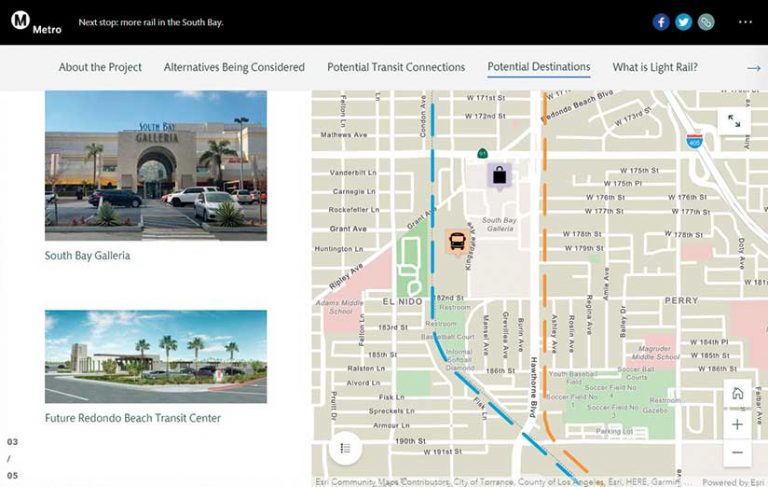Los Angeles County Metropolitan Transportation Authority (LA Metro) has undertaken an enterprise GIS modernization initiative designed to transform its business and build a better transportation future for the people of Southern California. Supporting LA Metro’s own people during this transformation has been a key strategy in the success of this initiative.
At LA Metro, location is central to everything the organization does. Bus and rail lines serve distinct geographic areas, with routes and stops located to meet the needs of the public. Physical assets and incidents have unique locations. Access to accurate location data is essential for mission-critical workflows, including maintenance and safety.
Multiple business units use ArcGIS software, but historically GIS workflows have been siloed. Different departments used different ArcGIS products and versions of those products. This siloed environment made it difficult to share data, plan, and collaborate across business lines.
Solving the Silo Challenge
LA Metro engaged Esri Services to help it implement a location strategy that would standardize its enterprise GIS infrastructure and applications while delivering new capabilities such as digital asset inspection and real-time situational awareness. This new strategy would also streamline departmental workflows, increase operational efficiencies, and enhance communication and collaboration among multiple teams.
This location strategy is being implemented in three phases. Each phase impacts workflows across the organization. Enterprise-wide adoption of new tools and apps relies on many individuals changing how they perform their daily work. This creates a challenge for employees and managers alike.
Early on, the location strategy team identified that supporting the workforce throughout implementation should be a key strategy. Consequently, Esri’s people-focused change management was included as a deliverable in the implementation plan.
LA Metro’s Information and Technology Services (ITS) department is coordinating the location strategy implementation. Phase 1 activities included ArcGIS Enterprise and ArcGIS Pro deployments and the development of apps that support asset management and other high-priority workflows.
Anika-Aduesa I. Smart, ITS GIS program manager, leads the adoption strategy. As project plans were communicated to GIS teams, Smart detected apprehension. This is a common reaction when familiar technology and entrenched workflows are changed. Smart’s goal was to devise an effective adoption strategy that would support both a successful phase 1 implementation and a healthy enterprise GIS ecosystem for the future.
“This was about building a community to deliver a cohesive business solution for everyone,” she said. Because change management was included in the location strategy implementation plan, Smart had tools at her disposal to win sustained support for a new approach to GIS.
A Turning Point
In fall 2020, Smart worked with Esri change management consultant Michael Green to deliver a customized, one-day virtual workshop called Preparing for Change. Workshop participants included GIS managers and professionals, project managers, and senior leadership from multiple LA Metro departments.
Smart understood that engaging these stakeholders would lead to a quicker pace of adoption after the phase 1 launch. In the longer term, this approach would promote wider adoption of GIS apps and technology.
“It was important for us all to be on the same page,” said Smart. One goal was gaining consistent sponsorship for the implementation through increasing participants’ awareness of GIS capabilities and business benefits. After establishing a common vision, participants encourage their employees to “think geospatial.”
During the workshop, each participant was asked, “If every member of your organization would fully embrace and unleash the power of your geospatial strategy, what would the outcome look like for your business?”
This question sparked brainstorming around new GIS apps that could benefit each department. Participants spent the afternoon exploring change management activities, including stakeholder analysis, communication techniques, and resistance management.

GIS for Everyone
Phase 1 of the location strategy implementation was completed at the end of 2020. The modern enterprise GIS infrastructure is now in place. Eleven departments are actively engaging with new ArcGIS apps.
Smart is committed to expanding adoption throughout LA Metro. She is marketing the value of GIS to departments that did not participate in phase 1. She’s adopted the slogan GIS for Everyone and focuses on sharing the message that technology can enhance their work and improve decision-making.
Through outreach activities like “lunch and learns,” Smart is broadcasting GIS team successes and building a network of GIS champions. These are classic change management strategies for maintaining momentum for change and reinforcing it so that new practices become embedded in the organization.
The hard work is paying off.
“People are more excited about GIS. It’s literally catching on like wildfire,” she said. Smart is working with the community relations department to integrate its data into the enterprise GIS. She is also working with the marketing department on a collaboration platform based on ArcGIS Hub. In addition to enabling easy access to information products that support marketing projects, the hub site will be a central location for LA Metro’s various GIS teams to share their work and collaborate. Sharing and collaboration between teams did not happen prior to the location strategy implementation.
The Road Ahead
For phase 2, Smart wants to ensure that executive sponsors remain actively engaged. In a large, busy organization, maintaining executive attention throughout a complex technology project is challenging.
The location strategy implementation plan includes a change management retainer package that Smart will use to test-drive ideas with Green. He acts as a sounding board and adviser on how to best utilize change management techniques when challenges arise.
“In some ways, we’re building the airplane while flying it,” Smart said. “Change management is a solid framework, but it also gives us flexibility to innovate and address unique situations in our GIS environment. It’s exactly in tune with what a successful GIS ecosystem should be: flexible and innovative.” The communication framework has helped Smart gain valuable insight into executive engagement, assess how well the implementation is being received, and adjust her efforts as needed.

People are more excited about GIS. It’s literally catching on like wildfire.
This approach has been successful. Bryan Sastokas, LA Metro’s chief information technology officer (CITO), remains an active sponsor of the initiative and encourages department leaders to embrace geospatial capabilities.
Leading change management efforts to support LA Metro’s location strategy has been a rewarding experience for Smart professionally. Her work has directly led to faster adoption of the technology and an increase in the number of GIS users. One of the most valuable outcomes of applying change management is that departments that once viewed ITS as trying to dictate technology use now view Smart’s team as a valued partner for improving efficiencies and innovating with GIS.
The implementation focus has shifted to data governance, and Smart is optimistic that change management techniques will continue to serve her well as more LA Metro departments embrace a location strategy.
To learn more about the Esri course, Preparing for Change. For more information on LA Metro’s initiative, contact Smart at SmartA@metro.net.





